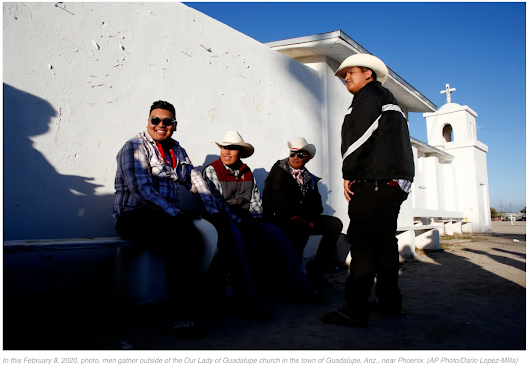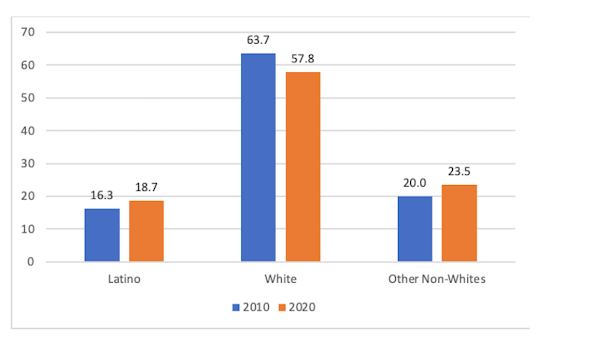University of Texas San Antonio professor and demographer, Dr. Rogelio Sáenz weighs in on the current U.S. Census count. It provides added perspective to my two earlier posts today:
I always think first of the children and how and whether we are taking care of their needs and well-being. I honestly believe that if we center our concerns on the youth, the rest will fall into place.
We must all do our part.
-Angela Valenzuela
Census 2020: More Than 1 in 2 People Added to U.S. Population Are Latino
The much-anticipated results of the 2020 Census for redistricting purposes are just in. The numbers illustrate the major changes that have been afoot in the U.S. population for some time. The nation’s population is becoming increasingly diverse due to major growth in the Latino, Asian, and multiracial populations and an aging white population that declined for the first time ever.
A total of 331.4 million were tallied in the 2020 Census, an absolute increase of 22.7 million people in the country. The Latino population led the way with slightly more than one of every two persons added to the country’s population through birth or international migration between 2010 and 2020 being Latino (Figure 1).
Figure 1. Percentage Distribution of U.S. Population Growth, 2010-2020
Overall, the Latino population increased by 23% during the decade while the white population declined by 8.6%.
Due to its aging population, the white population continued the downward slide of its share of the nation’s overall population at 57.8%., down from 63.7% a decade earlier (Figure 2). On the other hand, the Latino population increased its share of the population from 16.3% in 2010 to 18.7% in 2020 with a total Latino population of 62.1 million. These trends are in line with U.S. Census Bureau population projections suggesting that in 2044 whites will comprise less than half of the U.S. population. People of color now make up 42.2% of the U.S. population.
Figure 2. Percentage Distribution of U.S. Population by Race/Ethnicity, 2010 and 2020
Overall, the Latino population increased by 23% during the decade while the white population declined by 8.6%.
Due to its aging population, the white population continued the downward slide of its share of the nation’s overall population at 57.8%., down from 63.7% a decade earlier (Figure 2). On the other hand, the Latino population increased its share of the population from 16.3% in 2010 to 18.7% in 2020 with a total Latino population of 62.1 million. These trends are in line with U.S. Census Bureau population projections suggesting that in 2044 whites will comprise less than half of the U.S. population. People of color now make up 42.2% of the U.S. population.
Figure 2. Percentage Distribution of U.S. Population by Race/Ethnicity, 2010 and 2020
Some noteworthy changes reflecting the significant growth of the Latino population. First, the Latino population increased in all states and the District of Columbia.
Second, one of the most dramatic alterations in the Latino population is its increasing representation in an expanding swath of states around the country. The number of states where Latinos comprised more than 10% of the population climbed from 17 in 2010 to 27 in 2020 with Massachusetts, Nebraska, Oklahoma, Maryland, the District of Columbia, North Carolina, Delaware, Virginia, Georgia, and Wyoming joining the ranks in 2020 (Figure 3). This fanning out of the Latino population contrasts greatly to an earlier time more than a half-century ago when Latinos were clustered in the Southwest, Illinois, Florida, and New York.
Figure 3. States Where Latinos Represent 10% or More of Overall Population, 2020
Third, Latinos were the largest or second largest racial/ethnic group in 24 states in 2020 (Figure 4). California has now joined New Mexico to represent the two states where Latinos are the largest racial/ethnic group. Of the 22 states where Latinos make up the second largest group, Texas stands out with whites holding a slim percentage share advantage of 39.7% versus 39.3% for Latinos. It is projected that Latinos will outnumber whites in the state in 2022.
Figure 4. Twenty-Four States Where Latinos Represent the Largest or Second Largest Racial/Ethnic Group, 2020
Final Thoughts
There is undoubtedly an undercount of Latinos and other groups in the midst of the pandemic and the Trump Administration’s attempts to insert a citizenship question and to disallow the tally of unauthorized persons in the counts used to generate redistricting. Still, kudos go out to the good people at the U.S. Census Bureau who protected the integrity of the Census, produced the most accurate count of the population, and were able to fend off Trump’s directives to manipulate the count.
There is still a lot of greater details that will emerge over the coming months on the changing U.S. population. The true reality is that the nation is becoming increasingly diverse with Latinos in the forefront of this shift alongside Asians, Blacks, and persons identifying with multiple racial categories.
But one clear message emerges from the results of the 2020 Census, as the count will be used for redistricting purposes. Trucha, raza, we know the gerrymandering and underhand tactics that Republicans will use to dilute our community’s numbers. Remember that in our nation, whites sustained a decline of nearly 9% between 2010 and 2020 with Latinos increasing by 23%, a pattern replicated in many parts of the country.
Finally, on a personal note, I have been studying the demography of Latinos intensively since 1980. It has been an incredibly rewarding journey to see first-hand these tremendous changes and cannot wait to see what lies ahead.
***
Rogelio Sáenz is a sociologist and demographer. He is professor in the Department of Demography at the University of Texas at San Antonio. Sáenz is a regular contributor to Latino Rebels. Twitter: @RogelioSaenz42.





No comments:
Post a Comment